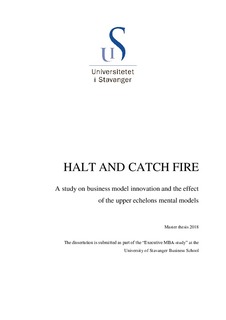| dc.contributor.advisor | Wathne, Kenneth H. | |
| dc.contributor.advisor | Fjeldstad, Øystein D. | |
| dc.contributor.author | Johansen, Cathrine Brudeseth | |
| dc.coverage.spatial | Norway | nb_NO |
| dc.date.accessioned | 2019-01-09T14:13:19Z | |
| dc.date.available | 2019-01-09T14:13:19Z | |
| dc.date.issued | 2018-05-22 | |
| dc.identifier.uri | http://hdl.handle.net/11250/2580029 | |
| dc.description | Master's thesis in Business administration: Executive MBA | nb_NO |
| dc.description.abstract | In the face of external shifts, the upper echelons set the strategic orientation for the company and innovate their business models accordingly. However, the industry has little understanding of the influence that dynamic conditions and the dominant logic of the firm has on business model innovation. The study applies a perspective of organizational behavioral theory to examine how business model innovation is affected by the top managers mental models. The methodology uses a longitudinal study by applying a qualitative content analysis. The sample consists of the five largest aquaculture firms in Norway listed on the OSE. The context is an uncertain market with substantial exposure to threat. Results show how the strategic orientation of firms govern the top managers risk attitude, which in turn lead to different organizational outcomes. This shows a predictably irrational behavior by the top manager’s that is anchored in their strategic orientation. Findings also demonstrate how company’s value configuration may influence innovation to firm’s business models. This is shown to act as a blinder to business model innovation and were found to be especially evident among defensive organizations. As such, the result positively confirms that top manager’s mental models are essential in the decision-making process related firm’s innovation of their business model. Based on an organization’s change perspective, the study intends to prove how top managers need to proactively challenge their mental models, both from an operative and dynamic standpoint. This, to maintain or regain competitive success in the complex market outlook. Those organizations that can learn to recognize the importance of building a diversified top management team will enable the firm to exploit and recognize both internal and external shifts, to a much greater extent. This will support firms in overcoming organizational inertia and make them appropriately fit to conduct more rational strategic choices. | nb_NO |
| dc.language.iso | eng | nb_NO |
| dc.publisher | University of Stavanger, Norway | nb_NO |
| dc.relation.ispartofseries | Masteroppgave/UIS-HH/2018; | |
| dc.rights | Navngivelse 4.0 Internasjonal | * |
| dc.rights.uri | http://creativecommons.org/licenses/by/4.0/deed.no | * |
| dc.subject | business strategy | nb_NO |
| dc.subject | organizational behavior | nb_NO |
| dc.subject | business model | nb_NO |
| dc.subject | business model innovation | nb_NO |
| dc.subject | value configuration | nb_NO |
| dc.subject | industry 4.0 | nb_NO |
| dc.subject | strategic management | nb_NO |
| dc.subject | strategic decision-making | nb_NO |
| dc.subject | upper echelon theory | nb_NO |
| dc.subject | mental models | nb_NO |
| dc.subject | managerial cognition | nb_NO |
| dc.subject | prospect theory | nb_NO |
| dc.subject | organizational inertia | nb_NO |
| dc.subject | threat-rigidity theory | nb_NO |
| dc.subject | strategy and management | nb_NO |
| dc.subject | strategi | nb_NO |
| dc.subject | ledelse | nb_NO |
| dc.subject | økonomi | nb_NO |
| dc.subject | strategisk ledelse | nb_NO |
| dc.title | Halt and catch fire – A study on business model innovation and the effect of the upper echelons mental models | nb_NO |
| dc.type | Master thesis | nb_NO |
| dc.subject.nsi | VDP::Samfunnsvitenskap: 200::Økonomi: 210::Bedriftsøkonomi: 213 | nb_NO |

